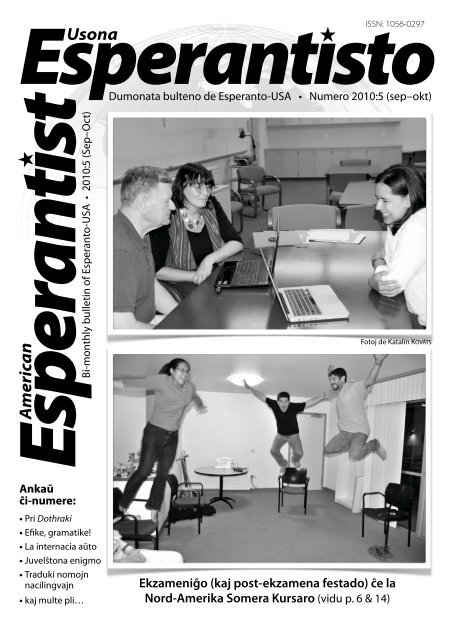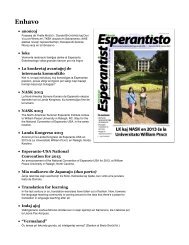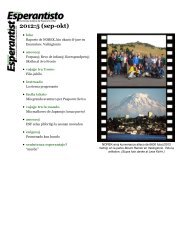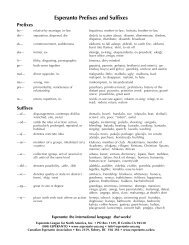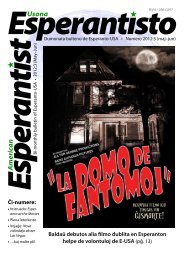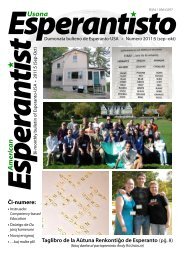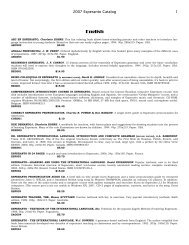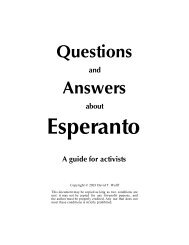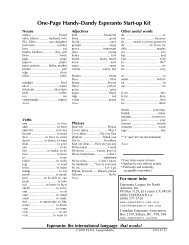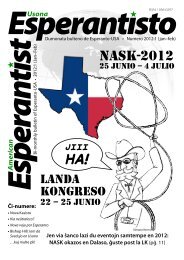Usona merica n - Usona Esperantisto - Esperanto-USA
Usona merica n - Usona Esperantisto - Esperanto-USA
Usona merica n - Usona Esperantisto - Esperanto-USA
- No tags were found...
Create successful ePaper yourself
Turn your PDF publications into a flip-book with our unique Google optimized e-Paper software.
EsperantıstoISSN: 1056-0297<strong>Usona</strong> EsperantıstA<strong>merica</strong>n Bi-monthly bulletin of <strong>Esperanto</strong>-<strong>USA</strong> • 2010:5 (Sep–Oct)Dumonata bulteno de <strong>Esperanto</strong>-<strong>USA</strong> • Numero 2010:5 (sep–okt)Fotoj de Katalin KOVÁTSAnkaŭĉi-numere:• Pri Dothraki• Efike, gramatike!• La internacia aŭto• Juvelŝtona enigmo• Traduki nomojnnacilingvajn• kaj multe pli…Elizabeto DORCASEkzameniĝo (kaj post-ekzamena festado) ĉe laNord-Amerika Somera Kursaro (vidu p. 6 & 14)
Regional eventsHere are just a few of the upcoming events forSeptember and October. For a more comprehensivelist, see .September 17 – 19 (Anacortes, WA)NOREK: Nord-Okcidenta Regiona<strong>Esperanto</strong>-KonferencoThe Northwest Regional<strong>Esperanto</strong> Conference isn’tso much a “conference” asit is a friendly get-together.The main event this year isa ride on the Washington State ferry between theSan Juan Islands. Other excursion possibilities areFriday Harbor and the famous Whale Museum.See orcontact Arlyn Kerr at .October 9 – 11 (Silver Bay, NY)ARE: Aŭtuna Renkontiĝo de <strong>Esperanto</strong>Come join us on theshores of beautiful LakeGeorge in the Adirondacksfor ARE, the 17th annualFall <strong>Esperanto</strong> Weekend!Organized by the <strong>Esperanto</strong>-Society of Québec,the event typically draws 50–80 people fromQuebec, Ontario, the northeastern US, as well asthe UK, Germany, Switzerland, even Japan!Courses, talks, games, hikes in the mountains,and much more. For more info, see or contact. (Below: participantson a mountain hike at ARE 2009 enjoy the view.)Local groupsBelow are contact addresses for some of the largerlocal groups that meet regularly; for more completeinfo, see our website.CaliforniaSacramento: http://esperanto.org/us/esosSan Diego: http://groups.yahoo.com/group/<strong>Esperanto</strong>GrupodeSanDiegoSan Francisco: http://esperanto.org/us/SFEROSanta Barbara: dorothyjeanh@gmail.comL.A.: http://fizzylogic.com/users/bulbul/esperanto/konversacia-rondoColorado (Longmont) http://ek-ek.orgConnecticut (Wallingford) http://esne.netDistrict of Columbia http://esperantodc.orgGeorgia (Atlanta) http://esperanto-atlanta.orgHawaii (Honolulu) http://esperanto.org/us/HonoluluIdaho (Boise) http://terpomuloj.orgIllinoisChampaign-Urbana: http://ekoci.orgChicago: http://esperanto-chicago.orgMaine (Bangor, Houlton) http://esne.netMassachusetts (Acton, Amherst, Cambridge,Northampton) http://esne.netMissouri (St. Louis) http://esperanto-stl.orgNew Jersey (Princeton)http://esperanto-nj.tripod.comNew YorkNew York: http://esperanto-nyc.orgRochester: http://esperanto.lodestone.orgOhio (Cincinnati) http://ligileto.freeshell.orgTexasAustin: http://esperantaklubo.konfuzo.netDallas: http://esperanto-tx.orgVirginia (Hampton Roads) http://bonege.comWashington (Seattle) http://seattleesperanto.orgWisconsin (Madison) http://groups.google.com/group/esperanto-societo-madison4 ! <strong>Usona</strong> <strong>Esperantisto</strong> ! 2010:5 (sep–okt) http://esperanto-usa.org
lokaj novaĵojVizito al SFERO kaj la CORaportas Filipo kaj Elizabeto DORCASSANFRANCISKO, KALIFORNIO — Libroj,amikoj, manĝaĵo… kia bona kolekto daĝuo. Tiel estis nia vizito al la Centra Oficejode <strong>Esperanto</strong>-<strong>USA</strong> la 24-an de julio.Ni “helpis” al Direktoro Vilĉo HARRISmeti novajn librojn en la ŝrankojn, elprenilibrojn laŭmende, envolvi ilin, metien skatolojn, surmeti adresojn kaj poŝtmarkojn,kaj eĉ kunporti iom al la poŝtoficejo.Okazis ankaŭ tago de Malferma Oficejoen kiu multaj vizitis, babilis kune,aĉetis librojn, kaj poste, kune tagmanĝis.Dankon al Vilĉjo HARMON, Anjo HAR-LOW, kaj Vilĉjo HARRIS, kiuj gastigis ilin,kaj la San-Franciska Esperanta RegionaOrganizo (SFERO) pro la varma bonveno,kuko, kaj tempo kune.KER-ekzamenoj ĉe NASK!SANDIEGO, KALIFORNIO — la 5-an dejulio okazis unuafoje en Nordamerikoekzamenoj de la prestiĝa Komuna EŭropaReferenckadro (KER) en <strong>Esperanto</strong>. Ilingvidis instruistoj Katalin KOVÁTS kajDuncan CHARTERS dum longa semajnfino.Ekzameniĝis entute 13 kandidatoj elUsono, Meksiko kaj Kanado. Por pli dadetaloj, vizitu .Katalin KOVÁTSOrda ĥaoso en la meznivela kurso de NASK. De maldekstre: Melissa DEMERS, Katalin KOVÁTS, Paŭleto BRENER,Harold GOODMAN, Gary ANDERSON, Aparecida ARAUJO. Foto danke al Katalin KOVÁTS. (Vidu ankaŭ p. 14.)6 ! <strong>Usona</strong> <strong>Esperantisto</strong> ! 2010:5 (sep–okt) http://esperanto-usa.org
David J. Peterson, a noted languagecreator, has been hired to flesh out theDothraki language from George R. R.Martin’s epic fantasy series A Song of Iceand Fire into a full-fledged, speakablelanguage. This constructed language, orconlang, is to be used for an upcomingHBO television series based on the novels.The title will be A Game of Thrones,after the first book in the series.The show’s producers hired the LanguageCreation Society to find an expertfor this job; out of thirty-five proposedversions of Dothraki, Peterson’s versionwas selected for the series.David J. Peterson studied linguistics atUC Berkeley (B.A., English and linguistics)and UC San Diego (M.A., linguistics).He started creating his own constructedlanguages in 2000, beginningwith a personal language based on <strong>Esperanto</strong>and Arabic; he has been active inthe conlang community since early 2001,including volunteer work for the LanguageCreation Society, and he’s one ofthe editors of Speculative Grammarian.His website showcases thirteen of hisconlangs (some more developed thanothers); his main project, Kamakawi, isinfluenced primarily by Hawai’ian. Mostof the linguistic details of his instantiationof Dothraki remain confidentialuntil nearer the time the TV series is tobe aired, but what’s been released so farsuggests that it’s an a priori, fusional andsynthetic language with influences fromRussian, Turkish, Estonian, Inuktitut andSwahili.conlangsDothraki and <strong>Esperanto</strong>: an interview with languagecreator David J. PetersonJim HENRYJim is a language creator whohas been speaking <strong>Esperanto</strong>since 1996. He lives inStockbridge, GA.jimhenry@pobox.comI interviewed David J. Peterson byemail in May 2010.How did you first get interested inconstructed languages?It was the convergence of three classesI was taking at the time: <strong>Esperanto</strong>, Arabicand Introductory Linguistics. Due inlarge part to the influence of <strong>Esperanto</strong>and all the natural language data I wasgetting in linguistics, I hit upon the ideathat someone could create a language notfor international communication (<strong>Esperanto</strong>,I reasoned, fit the bill for that), butjust for personal use—say, betweenfriends. As soon as the idea hit me (itwas in a linguistics class), I immediatelystarted designing the phonology for myfirst language: a poor project with theregularity of <strong>Esperanto</strong> and the structureof Arabic. I would later discover that Iwasn’t the first to have this idea.Who taught that <strong>Esperanto</strong> course atBerkeley? What was it like?That was actually the first time thatparticular <strong>Esperanto</strong> DeCAL course wastaught at Berkeley, and it was co-taughtby Lana Shlafer and Mina (or Stelet)Kim. I thought it was a unique experiencesince both Lana and Mina had beenspeaking <strong>Esperanto</strong> since birth (theywere raised bilingual in <strong>Esperanto</strong> andtheir native language—Russian and Ko-http://esperanto-usa.org <strong>Usona</strong> <strong>Esperantisto</strong> ! 2010:5 (sep–okt) ! 7
ean, respectively). It’s one thing to take acourse in a constructed language, andquite another to take it from two nativespeakers.I still remember everything I learned.All I would need to communicate comfortablyin <strong>Esperanto</strong> is more vocabulary(well, that and I’d probably avoid usingany participles). When it comes to a languageinstruction course, I can’t think ofhigher praise to offer – though, of course,it was also a lot of fun. I still have myUSEJ sticker on my guitar case.What, if anything, did you alreadyknow about <strong>Esperanto</strong> before taking thatcourse? What motivated you to take<strong>Esperanto</strong> rather than one of the otherlanguage courses offered that semester?My mother told me about <strong>Esperanto</strong>when I was a senior in high school(though I still can’t figure out how it evercame to her attention). That was the firsttime I’d ever encountered the idea that ahuman could invent a language. Itseemed pretty outlandish at the time.Several months later, we were at a librarybook sale and I came across Step byStep in <strong>Esperanto</strong> by Montagu C. Butler. Ilooked that over, and took it with me toBerkeley.As for the course, language classes atBerkeley are five units. That semester Iwas taking Arabic and Russian, in additionto a class for my English major andintroductory linguistics. All told, thatcomes to 18 units—a hefty load for afreshman (average is 12; heavy is 15). Iwasn’t planning on taking any otherclasses that semester, but during the firstweek I saw a flier for the <strong>Esperanto</strong> De-CAL posted on the front door of mydorm. I had a good experience with thePart of a preview from HBO’s upcoming televisionseries Game of Thrones, based on George R. R.Martin’s books. The series will use David J. Peterson’sexpanded version of the Dothraki language.previous DeCAL I’d taken (on the Doorsand Jim Morrison’s poetry), and figured Ialready knew a bit about <strong>Esperanto</strong>, sotacking on another class wouldn’t be toomuch trouble.Which of your own conlangs is thebest developed? Which is your favorite?Same answer for both questions: Kamakawi.Kamakawi was the first languageI created after I realized that myprevious languages suffered from seriousflaws (beginners’ mistakes; everyonemakes them). Even so, the languagewasn’t perfect to begin with, but I’vestuck with it over the years, and havereally gotten it to a good place.You’ve mentioned before that you’renatively bilingual in English and Spanish.Do you reckon that infuenced yourinterest in languages and linguistics, orin conlanging?In the long run, perhaps, but initially,quite the opposite. It’s very difficult toraise a child to be truly bilingual; usuallyone language predominates over the8 ! <strong>Usona</strong> <strong>Esperantisto</strong> ! 2010:5 (sep–okt) http://esperanto-usa.org
other. In my case, that was English. I wasdoing pretty well with Spanish, but then Iwas moved away to Fresno, away frommy mother’s side of the family. There Ihad pretty much no regular contact withSpanish speakers any longer, and Englishtook over. By the time I moved back, I’dlost too much time, and Spanish becamea source of frustration for me. I tried toblock it out, ignore it—and the thoughtof learning languages other than Spanishwas abhorrent to me. That was a seriousroadblock. I had to reclaim my fluencyand tap into my native knowledge (andfor that, I have not only mySpanish teachers to thank,but my grandmother. I’vealways understood her Spanish,and she never gave upspeaking it to me).What can you tell meabout Dothraki semanticsand pragmatics?I tried at all times to adhereto the ideals espousedby the Dothraki in George R.R. Martin’s books. There’s akind of Dothraki mindsetthat one gleans from the books. They’rewarriors, of course, but there’s also a seriesof dualities. For example, the Dothrakiare nomadic, yet they have onefixed city (Vaes Dothrak), and there’s acertain code of behavior that applies tobeing in the city, and a different one forbeing elsewhere. I tried to bring thesedifferent senses of place into the languagewhere possible.For example, in Dothraki somethingdone in secret is done torga essheyi —literally,“under a roof ”. The Dothraki believethat all honorable acts are undertakenbeneath the open sky, so to dosomething under a roof—out of the lightof day—is to do it secretly, and in a waywhich doesn’t merit approval.Is the form of the Dothraki word “ido”(wooden, fake) an inside joke vis-a-visthe <strong>Esperanto</strong>/Ido schism?Hee, hee… You caught me! I would liketo say, though, I don’t wish the Ido communityill, by any means. Think of it askind of good-natured ribbing—the wayone might tease someone from a rivalschool. But make no mistake: If I werechoosing sides in an <strong>Esperanto</strong>-Ido athleticcompetition, I’d proudlywear a green star sweater.How would you say “ne alglavo sangon soifanta” (notto a sword thirsting forblood) in Dothraki?Man, what a line to choose!You’re really making mework for this. I’m even goingto have to dust off theseldom-used present participle…Nice not to have tocoin any words, though.Vos arakhaan feveya qoyoon...Dang, 11 syllables… Of course, if thiswere in verse, I’m sure the vos could beclipped to v’. That’d give us 10. Anyway, Iwould note here that this is the translationof a line of verse, and that the phrasing,as a result, is unusual (if I had thefull sentence with the verb, I think I’d doit a different way, but without the verb,this is the best way).[Editor’s note: The extended interviewwith supplemental info can be found at.] http://esperanto-usa.org <strong>Usona</strong> <strong>Esperantisto</strong> ! 2010:5 (sep–okt) ! 9
instruadoAlternatives to traditional language classesLanguage teaching in the traditionalsense has for the most part meant classroominstruction, either as part of abroader curriculum or as a stand-alonecourse. In recent decades, especially inthe U.S., this approach has been in declinefor a variety of reasons, including schoolbudget problems and shifts in priorities.One interesting exception has been anincrease in the teaching of Chinese, andnot just because of China’s growingglobal importance. The Chinese governmentunderwrites the pay of some Chineselanguage teachers in the U.S. andother countries, so that school systemsunable to afford to teach other languagescan offer Chinese at far lower cost. 1Unfortunately, <strong>Esperanto</strong> is one of thelanguages experiencing a decline in classroomteaching, as reflected in reportscollected by the A<strong>merica</strong>n Association ofTeachers of <strong>Esperanto</strong>. (If you teach an<strong>Esperanto</strong> course, please let us know.You’ll find a form on our website at and in every issue of theAATE newsletter.)This decline doesn’t necessarily meanfewer people are learning <strong>Esperanto</strong>,however. Recent years have seen an explosionin <strong>Esperanto</strong> classes online, mostnotably via Lernu.net. As a consequenceof the decline in formal teaching and therise in online courses, the fraction of selftaught<strong>Esperanto</strong> speakers, always largein comparison with students of otherlanguages, is now probably higher thanever. Of course, the online courses arenot always entirely self-taught. There areoften ways of getting help from a livevolunteer tutor.D. Gary GRADYGary is Vice President of theA<strong>merica</strong>n Association ofTeachers of <strong>Esperanto</strong>(AATE). He lives in Durham,NC.dgary@mindspring.comSo is classroom teaching even relevanttoday? Certainly! For all the difficulty inorganizing and offering a conventionalclass, it remains one of the most efficientways to teach a language to a substantialnumber of people, as Andreo Cseh inparticular demonstrated decades ago.But at the same time, it’s clear we needto recognize how people today actuallylearn <strong>Esperanto</strong> and we need to thinkabout what we can do to make it better.That’s an open-ended subject, so I’ll limitmyself to just a few suggestions, a few ofwhich I’ve touched on before.First, the best known and most successfulclassroom courses are those offeredas part of the North A<strong>merica</strong>nSummer <strong>Esperanto</strong> Institute (NASK),currently at the University of Californiaat San Diego. These are intensive threeweekclasses taught at several levels. Forthose who can afford the time and thecost (note that financial aid is available),NASK is possibly the best way to advanceone’s knowledge of <strong>Esperanto</strong> in theshortest amount of time. Similar programsof varying lengths are offered inother countries and are also worth investigating.For those of us with less free time ortravel funds, weekend courses are sometimesoffered by regional <strong>Esperanto</strong> or-10 ! <strong>Usona</strong> <strong>Esperantisto</strong> ! 2010:5 (sep–okt) http://esperanto-usa.org
Chris WINGROVEHej gejunuloj! Ĉu interesas vin landagrupo de junaj esperantistoj? Kelkaj junajusonanoj nun klopodas revigligi la junularanmovadon en nia lando – kaj ni volaske ankaŭ vi partoprenu! Do se vi volasrenkonti aliajn mojosajn junajn esperantistojn,kaj eble eĉ uzi tiun ĉi lingvon, bonvolukontakti nin aŭ retpoŝte (la preferatamaniero) aŭ poŝte:usejusona esperantista junularowww.usej.orgChris WingroveCPU Box 274791University of RochesterRochester, NY 14627Amike, :)Chris kaj AndyjunulareAndy ROSENBAUMHey youngfolk! Have any interest in a nationalgroup for young Esperantists? Severalof us are now working to revive the youthmovement in the US of A—and we’d like youto be a part of it! So, if you want to meet otherawesome young Esperantists, and maybeeven use the language, please contact useither by email (preferred) or by snail mail:ganizations, and kongresoj and localmeetings can serve as de facto immersioncourses. It’s amazing how muchfluency improves during a week at anUniversala Kongreso.One way to make local meetings moreeffective is to dedicate a little time ineach gathering explicitly to languagelearning. One possibility is for everyoneto work through a course or textbook,such as William Auld’s Paŝoj al PlenaPosedo or Boris Kolker’s Vojaĝo en<strong>Esperanto</strong>-lando (part of the latter can befound on Lernu.net). This is one of thethings the Raleigh-Durham group didwhen it first started. It’s probably best notto devote the whole meeting to study,since that gets to be a bit too much likehomework, but a little of it can help relativebeginners catch up to the more experiencedspeakers, and it tends to helpeverybody improve their abilities ratherthan just maintain them.A related idea is for everyone to read ashort article or listen to a podcast in <strong>Esperanto</strong>(either during the meeting or inadvance) and then talk about the subjectmatter, the vocabulary, and the grammarused. Among other things, this helpsreduce the risk of developing a local dia-http://esperanto-usa.org <strong>Usona</strong> <strong>Esperantisto</strong> ! 2010:5 (sep–okt) ! 11
lect of <strong>Esperanto</strong> rather than learning theinternational norm.Yet another possibility is to translate ashort paragraph or so of colloquial Englishinto <strong>Esperanto</strong>, since that can sparksome interesting discussions and yieldcreative solutions that offer insights intohow to employ <strong>Esperanto</strong>’s remarkableexpressive capabilities. In La Bona Lingvothe late Claude Piron mentioned howmuch he learned translating prose intosimple, beginner-level <strong>Esperanto</strong>, and ifClaude Piron could benefit from thatexercise, surely the rest of us can do so.Incidentally, a language teachingmethod popular in a number of Europeancountries is to have students spendpart of each class teaching each other,and that’s basically what happens when alocal group devotes some meeting timeto deliberate teaching.Technology has done a lot to help isolated<strong>Esperanto</strong> speakers practice the language,for example by exchanging emailinternationally. There are mailing listsand discussion forums devoted specificallyto learning, and these can amountto an Internet analog of a local group. Youcan find discussions online at Lernu.netand of course at esperanto-usa.org, andyou can search in both groups.yahoo.comand groups.google.com for mailing listsdevoted to “learning <strong>Esperanto</strong>” or“<strong>Esperanto</strong>-lernado” and the like. You’llbe surprised by the number of possibilitiesout there. Often you can read recentmessages before joining the group to seehow active it is and at what level it operates.The energetic Chuck Mays, anotherofficer of AATE, is currently investigatingthe practicality of using free and inexpensiveonline video conferencingservices for purposes of virtual meetingsand classes. All it takes is an inexpensivewebcam (now built into many laptopcomputers) and a reasonably fast Internetconnection.Here in east-central North Carolinawe’ve enjoyed meetings in which one ofthe participants is actually more than athousand miles away but still present onthe screen of a laptop, able to join in theconversation almost as if he were actuallyhere.There are also virtual worlds such asSecondLife.com that allow people to attendmeetings as if together in an imaginarylocation, or a sort of cartoon versionof a real one.With the spread of broadband Internet,it may soon become the most commonmedium for <strong>Esperanto</strong> classes of the future(and not just <strong>Esperanto</strong>, for thatmatter). I’ll have more to report on theseexperiments in a later column. In themeantime, try it yourselves and sharewhat you learn.1 http://nytimes.com/2010/01/21/education/21chinese.html Senintenca esperantaĵo?Montego Hills – ĉu ne memkontraŭdiro? Fotitaen San Jose, Kalifornio de Gregory TSEYTIN.12 ! <strong>Usona</strong> <strong>Esperantisto</strong> ! 2010:5 (sep–okt) http://esperanto-usa.org
traduk-interŝanĝoĈi-numere ni prezentas kanton tradukitanel la hebrea fare de Ŝajo MOR en Kanado.Ekzistas florojVerkis Natan JONATAN, 1970Elhebreigis Ŝajo MORĈu vi vidis tian belan belecon?Tia, kia tremis pro aŭtuna vento.En l’ obskuron estingiĝis orkamp’kaj ekbruligis kandelojn de scilo.Ĉu vi vidis tian ruĝan ruĝecon?tia, kia vokis al distancoj.Tie antaŭe estis kampo de sango,kiu nun iĝas kampo de papavoj.[refreno]Ne pluku, knabo mia!Ekzistas floroj forpaseblaj,Ekzistas floroj kiuj senfinedaŭras en la melodio.Ĉu vi vidis, kio nigriĝis tie?Ĝi estas dornkampo, mia knabo,forlasita de l’ somer’,kaj nun ĝi ja estas rikoltkampo.Ĉu vi vidis, kio blankiĝis tie?Knabo mia, ĝi estas larmkampo.Ĝiaj larmoj iĝas ŝtonoj plorantaj,ĝiaj ŝtonoj iĝos floroj florantaj.Pri la fono, Ŝajo klarigas:“La kanto estas ofte uzata en memortagojde falintaj soldatoj, nunankaŭ por civilaj viktimoj de terorismo.La aŭtoro perdis sian filon, kiuestis juna soldato, dum milito.Kiam temas pri verkistoj, granda,vivskua tragedio ofte varbas iliajn plejaltajn kreofortojn kaj rezultigas majstroverkonkiu trafe tuŝas la animojn demultaj.Interalie, la kanto uzas kiel gvidmotivonla temon de endanĝerigataj sovaĝfloroj– kiuj multe ekzistas en lalando kaj estas laŭleĝe protektatajkontraŭ plukado – kaj iom komparastiujn ĉi endanĝerigatajn florojn kunfalintaj soldatoj.”Korespondi dezirasMia nomo estas Mikelo, kaj mi ŝatas ricevikorespondon de samideanoj. Ne havantefamilion, estus plaĉe ricevi leterojn de iu. Miatempo en malliberejo klerigas min. Mi ne nurlernas <strong>Esperanto</strong>n, sed mi daŭre edukas min,kompletigante la komercajn klasojn, plumbistajnklasojn, kaj aliajn programojn, kiujhelpas plibonigi homon. Mi scias, ke viajleteroj helpos min pri tio. Dankon.Michael SET TLEMIRE #151152, ASPCFlorence/South, P.O. Box 8400, FlorenceAZ 85132-8400Mi estas pola esperantistino kaj mi korespondaskun kelkaj amikoj el diversaj landoj.Bedaŭrinde mankas al mi esperantistoaŭ esperantistino el Usono. Ĉu vi povushelpi al mi? Mi loĝas en norda Pollando,proksime al Gdansk, ĉe Balta Maro. Mi estisinstruistino, nun mi jam ne laboras kaj okupiĝaspri <strong>Esperanto</strong>. Amike, Jadviga.Finn-sveda esperantistino kun parencoj kiujenmigris al Usono antaŭ 100 jaroj, deziraskorespondi kun usona esperantisto interesatade genealogio. Mi estas emerita sociallaboristino.Soile Lingman, Ringvagen 72, SE 118 61Stockholm, Swedenhttp://esperanto-usa.org <strong>Usona</strong> <strong>Esperantisto</strong> ! 2010:5 (sep–okt) ! 13
NASKLa internacia aŭtode Aparecida ARAUJO[Jen parto de raporto verkita de brazilastudantino en la ĉi-jara Nord-Amerika SomeraKursaro de <strong>Esperanto</strong> (NASK). La raporto unueaperis en “La NASKa Fasko”, ĵurnalo de la kursaro.Se vi volas legi pli, la Fasko haveblas reteĉe . —Red.]Bonŝance la periodo de NASK koincidiskun la 4-a de julio, kiu gravas enUsono, ĉar antaŭ 234 jaroj, en 1776, estisakceptita la Deklaro de Sendependeco.Por kuncelebri, NASKanoj estis invititajspekti piroteknikaĵojn en la vilaĝo LaJolla post la sunsubiro. Kelkaj havisaŭtojn, kaj ĝentile savis nin de la antaŭvidita,prema aŭtobusa reveno.Survoje d-ro Katalin KOVÁTS observisla internaciecon de nia aŭto. Fenomenokiun nur <strong>Esperanto</strong> povas okazigi. Personojel kvar kontinentoj, el ses landoj, elses malsamaj naciaj lingvoj, (Meksiko,Argentino, Brazilo, Hungarujo, Israelokaj Irano), pere de <strong>Esperanto</strong> gaje paroliskaj facile komprenis unu la alian.Estis tiom signifa okazaĵo por niagrupo, kaj Katalin havis la ideon foti, kajankaŭ mi kaptis la okazon registri, ĝusteantaŭ la domo de d-ro David JORDAN. Lipiede kondukis nin laŭ la marbordo, enLa Jolla, ĉar la aŭton oni devis lasi tie,pro amaso da homoj en la urbocentro.La piroteknikaĵoj estis treege belaj, kajdaŭris pli-malpli 30 minutojn.D-ro Jordan afable prizorgis pripoŝlampoj por ĉiuj ni, por la mallumalaŭmarborda reveno. Li ankaŭ afableregalis nin per biero, pufmaizo kaj bongustajmaizflokoj, dum ni atendadis ladisiĝon de la densa trafiko, tuj post lapiroteknikaĵoj.Estis tre interesa programo, kaj portiom kaj tiam, dankon al nia majstrod-ro Lazaro Ludoviko ZAMENHOF. La NASK-anoj grupfotiĝas ĉe la kampuso de UCSD en junio. Aparecida estas tria de la dekstra flanko.14 ! <strong>Usona</strong> <strong>Esperantisto</strong> ! 2010:5 (sep–okt) http://esperanto-usa.org
traduku!Traduki nacilingvajn nomojn estas eterna defioPor la ĉi-monata defio, ni elektis tekstonel la romano Slaughterhouse-Fiveverkita de Kurt VONNEGUT. La romanohavas trajtojn de sciencfikcio, kaj niajtradukintoj aliris la problemojn de tiuĝenro diversmaniere. Ni dankas al TD,SN, JP, RW, and GB pro iliaj tradukprovoj.Ĉiuj tradukprovoj estis sufiĉe similaj,krom kelkaj detaloj. Tiu unueco verŝajnedevenas de la lingvaĵo de la romano.Vonnegut verkas plej ofte rekte kaj klare.La lingvaĵo en la cititaj alineoj ne estaspoezio, kaj tradukisto ne devas faristrangajn tordaĵojn por elturniĝi.Ni volas atentigi ke en la provoj troviĝistro da eraroj pri la n-finaĵo, kaj enpluraj estis diversaj aliaj gramatikaj problemoj.Nu, erari estas home, kaj ĉiu el nieraras, sed ni konsilas ke en tia kvazaŭ“konkurso” oni zorge provlegu la tekstonantaŭ ol ĝin sendi. Cetere, pri la n-finaĵo,konsciu ke ĝi funkcias laŭ reguloj, kaj onine uzu ĝin kie regulo ne indikas. Fojeŝajnas ke homoj simple ĵetas manplenonda n-oj sur la paĝon, kun la espero ke ilifalu en la ĝustajn lokojn. Sed <strong>Esperanto</strong>,kvankam ne tute logika, tute ne uziĝasnur per hazardo.En la romano, rolas la loĝantoj de foraplanedo. En la angla, la estaĵoj de tiuplanedo estas Tralfamadorians, kaj laplanedo Tralfamador. Iuj tradukintojelektis Tralfamadoro kiel la planedon kajtial tralfamadorano kiel la loĝanton kajtralfamadora kiel nomon de ilia lingvo.Aliaj tradukintoj komencis je Tralfamadoriokiel nomo de la planedo, do sekvastralfamadoriano kaj tralfamadorianalingvo. Amuze, ke mankas la -uj sufikso.Alia, zamenhofa aliro al la defio estasLee MILLERTim WESTOVEREn ĉi tiu rubriko ni prezentas tradukdefiojnpor vi. Leginte viajn tradukojn, ni faros resumonde la plej bonaj provoj kaj sukcesoj, kunekun komentoj kaj reagoj pri kelkaj malpli sukcesajrezultoj. Bonvolu sendi ne plurajn diversajnprovojn, sed nur unu tradukon antaŭ la1-a de novembro al:bulteno@esperanto-usa.orgTralfamadorujo, tralfamadoro, kaj tralfamadoralingvo – ĉu pli plaĉa?La ĉefa homa rolulo nomiĝas Billy Pilgrim;traduki nacilingvajn nomojn estaseterna defio por tradukanto. Fojfoje onitrovas nomojn senŝanĝajn, en nacilingvaortografio. Por nomoj el lingvoj, kiuj neuzas latinajn literojn, tiu aliro tamen nefunkcias, kaj eĉ latinliteraj nomoj ofteprezentas problemojn. Ĉar Billy havasduoblan l kaj y, hispanparolanto certevoĉigus la nomon malsame, ol anglaparolanto.Bili konservas la elparolon de la anglased ne sekvas la regulojn de <strong>Esperanto</strong>vortfarado.Ĝi similas verbon, ne substantivon/ nomon.Tria aliro baziĝas sur la fakto, ke Billestas karesformo de William, kies kutimaEsperanta traduko estas Vilhelmo, karesformeVilĉjo. (Iu proponis Bilĉjo, sed tioŝajnas al ni misformo – el kiu esperantanomo ĝi estas farita?) Sed la rezulto estashttp://esperanto-usa.org <strong>Usona</strong> <strong>Esperantisto</strong> ! 2010:5 (sep–okt) ! 15
nomo, kiu apenaŭ similas la originalan.Kiun tradukon vi uzus?Plej sube aperas la anglalingva fontotekstokun nia proponita traduko sinteza.Por la venonta defio, ni proponas revenonal poezia – moderna kaj malfacila:XAIPE: 49 de E. E. CUMMINGS.this is a rubbish of human rindwith a photographclutched in the halfof a hand and the wordlove underlinedthis is a girl who died in her mindwith a warm thick screamand a keen cold groanwhile the gadgets purredand the gangsters dinedthis is a deaf dumb church and blindwith an if in its souland a hole in its lifewhere the young bell tolledand the old vine twinedthis is a dog of no known kindwith one white eyeand one black eyeand the eyes of his eyesare as lost as you’ll findBonan tradukadon! Sinteza traduko de la pasintnumera defio, ĉerpita el la romanoSlaughterhouse-Five de Kurt VONNEGUT:Billy couldn’t read Tralfamadorian, ofcourse, but he could at least see how thebooks were laid out—in brief clumps of symbolsseparated by stars. Billy commented thatthe clumps might be telegrams.“Exactly,” said the voice.“They are telegrams?”“There are no telegrams on Tralfamadore.But you’re right: each clump of symbols is abrief, urgent message—describing a situation,a scene. We Tralfamadorians read themall at once, not one after the other. There isn’tany particular relationship between all themessages, except that the author has chosenthem carefully, so that, when seen all at once,they produce an image of life that is beautifuland surprising and deep. There is no beginning,no middle, no end, no suspense, nomoral, no causes, no effects. What we love inour books are the depths of the many marvelousmoments seen all at one time.Vilĉjo ne povis legi la tralfamadoran,kompreneble, sed li povis almenaŭ vidi kiella libroj estis aranĝitaj – en malgrandaj grupojde simboloj apartigitaj per steloj. Vilĉjokomentis, ke la simboloj povus esti telegramoj.“Ĝuste”, diris la voĉo.“Ĉu vere telegramoj?”“Ne ekzistas telegramoj sur Tralfamadorujo.Sed vi pravas, ke ĉiu grupo de simbolojestas mallonga urĝa mesaĝo, kiu priskribassituacion aŭ scenon. Ni tralfamadoroj legasĉiujn la simbolojn samtempe, ne unu postla alia. Ne estas rilatoj inter la mesaĝoj,krom tio, ke la aŭtoro zorge elektis ilin porkune krei bildon de vivo bela kaj surprizakaj profunda. Ekzistas nek komenco nekmezo nek fino; ne estas streĉo, moralaĵo,kialoj, rezultoj. Tio, kion ni amas en niajlibroj, estas la profundeco de multaj mirigajmomentoj viditaj samtempe.16 ! <strong>Usona</strong> <strong>Esperantisto</strong> ! 2010:5 (sep–okt) http://esperanto-usa.org
[Jen inaŭguro de nova rubriko cele al progresantoj,danke al la laboro de junulo SteĉjoCYBULSKI. En 2008 li ekkomencis studi <strong>Esperanto</strong>nen baznivela kurso, kaj jam ĉi-jare li fariĝisunu el la unuaj usonanoj kiuj sukcese trapasisla prestiĝan KER-ekzamenon je nivelo C1 – laplej alta nivelo je kiu oni povas ekzameniĝi.Pro lia rapida spertiĝo kaj freŝaj memoroj delaŭvojaj lern-defioj, mi esperas ke progresantojtrovos liajn konsilojn aparte utilaj. —Red.]efike, gramatikeVortfarado per nekutimaj kombinoj de sufiksojkaj gramatikaj finaĵojSteven CYBULSKISteĉjo estas fervoragramatikemulo. Li nunloĝas en Madisono,Viskonsino.stcybulski@gmail.comEkzistas tre multaj lerniloj por komencantojde <strong>Esperanto</strong>, kaj ankaŭ pormezniveluloj la vojo al pli bona rego dela lingvo estas prilumata de multaj kursoj,libroj, kaj la helpo de pli spertaj esperantistoj.Tamen, por tiuj homoj kiuj jampovas esprimi sin pli malpli kontentigesed malgraŭ tio restas ekster la vicoj de laplej fluaj parolantoj, la vojo antaŭen estasmalpli hela. Estas amaso da gramatikaĵojkaj stilaj konsideroj kiuj treege gravas enkaj la parola kaj la skriba lingvo, sedkiujn oni malofte klarigas eksplicite. Entiu ĉi nova rubriko Efike, Gramatike, miprovos laŭ miaj kapabloj ĵeti iom dalumo al tiuj lingvaj iloj per kiuj oni povasatingi pli belan kaj esprimpovan uzon denia lingvo. Mi neniel pretendas esti aŭtoritato;ankaŭ mi estas ordinara uzanto de<strong>Esperanto</strong> kiu daŭre lernas, sed ĝuste protio mi opinias ke miaj spertoj kaj eltrovojeble helpos al aliuloj. Tute ne temos ĉi tiepri teoriaj disputoj aŭ harfendado. Male,mi celas igi la rubrikon loko kie vi trovospraktikajn, tuj uzeblajn konsilojn.En mia unua artikolo, mi volas rimarkigial vi esplorindan rimedon de laEsperanta sistemo de vortfarado: vortfaradoper nekutimaj kombinoj de sufiksojkaj gramatikaj finaĵoj. Antaŭ nelongemi rimarkis ke multaj aŭtoroj kiujn miadmiras plene ekspluatas ĉi tiun rimedon,kaj kiam mi komencis uzi ĝin mitrovis ke mi povis esprimi miajn pensojnkaj sentojn pli facile. Kvankam principeoni povas uzi ĉiun sufikson kun ĉiu gramatikafinaĵo, en la praktiko ne ĉiujkombinoj estas egale utilaj. Mi do klarigosĉi tie nur kelkajn kombinojn kiujnmi efektive uzas, sed kompreneble vimem povos esplori la multajn aliajneblojn.Unue, ni konsideru la sufikson IG. Ĉiufreŝbakita esperantisto scias ke ordinareoni faras per ĝi verbojn: el blanka, onifaras blankigi; el boli, boligi; el manĝi,manĝigi, ktp. Sed tre ofte, iu aĵo aŭ agohavas la econ, ke ĝi kaŭzas staton aŭagon, kaj oni povas tion indiki per IGadjektivoaŭ IG-adverbo. Ekzemple, setrafa solvo al iu problemo kontentigasvin, vi povas diri ke ĝi estas kontentigasolvo. Se iu preleganto parolas tiel malklareke vi misaŭdas lin, vi povas diri keli parolas misaŭdige. Per tiaj adjektivojkaj adverboj, oni povas esprimi sin egeprecize kaj koncize. Ankaŭ IGsubstantivojestas utilaj, kaj almenaŭ unu(kaj probable multaj aliaj) jam envenis endaŭrigo sur paĝo 19…http://esperanto-usa.org <strong>Usona</strong> <strong>Esperantisto</strong> ! 2010:5 (sep–okt) ! 17
enigmojNomoj de juvelŝtonoj en <strong>Esperanto</strong>Kiom da nomoj de juvelŝtonoj vi sciasen <strong>Esperanto</strong>? Jen instrua kvizeto kundifinoj de dek gemoj. La priskribojnsekvas indikoj pri fundamenteco (*),oficialeco (1-a aŭ 2-a Oficiala Aldono),aŭ zamenhofeco (Z) de la nomoj.Plenigu la skatoletojn per la nomoj de lapriskribitaj gemoj; legante la unuajnliterojn de ĉiu nomo de supro malsupren,vi trovos avertan frazon por tiuj,1. 2. 3. 4. 5. ’6. 7. 8. 9. 10. kiuj tro entuziasmas pri tiaj luksajŝtonoj…Por konkursi, sendu vian solvon al laredakcio, aŭ poŝte aŭ rete, antaŭ la 18-ade oktobro. Ĉiuj membroj rajtas partopreni.Inter la solvintoj ni lotos pri $10-rabato de la libroservo de E-<strong>USA</strong>.Multan dankon al Russ WILLIAMS, kiuelpensis tiun ĉi enigmon!1. violkolora gemo (*)2. ruĝa gemo (*)3. senkolora gemo (*)4. gemo kun diverskolorajtavoloj (2)5. ruĝa gem’ (aŭ blua, kazede Ŝerloko Holmso…) (Z)6. blanka aŭ blua gemo kunŝanĝkoloraj rebriloj (*)7. blua gemo (*)8. verdablua gemo (*)9. speco de kvarco kundiverskoloraj vejnoj (1)10.verda gemo (*)18 ! <strong>Usona</strong> <strong>Esperantisto</strong> ! 2010:5 (sep–okt) http://esperanto-usa.org
Estas tre bonŝance ke nia ĉi-numeragajninto estas Russ WILLIAMS, ĉar li nerajtas partopreni en la nuna konkurso –pro tio, ke li mem elpensis la enigmon!Do gratulon al li, kaj laŭrojn ankaŭ al laaliaj sukcesintoj: Vilĉjo HARMON, ArlynKERR, Georgo BAKER, Filipo kaj ElizabetoDORCAS, Nick KALIVODA, PeterMCCORQUODALE, Lucas GRAVES, WilliamPECKENPAUGH, Dave RUTAN, E.James LIEBERMAN, Amanda SCHMIDT,Olga DU TEMPLE, Ray REDD, CorneliusMCKOWN kaj Keneĉjo GOLDBERGO.La temo de la pasintnumera limerikoenigmo(ankaŭ tion elpensis Russ!) estisla filmo Slumdog Millionaire.Solvo de numero 2010:4Efike, Gramatike: daŭrigo de paĝo 17…la ĉiutagan lingvon: UEA estas mallongigode Universala <strong>Esperanto</strong>-Asocio.Tiaj substantivoj ofte uzindas ekzemplekiam oni volas pridiskuti ian ŝanĝon: lamultekostigo de flugoj, la esperantigo aŭelangligo de dokumento, ktp.Nun ni pluiru al la sufikso EC. Kutimeoni faras per EC substantivojn: gravafariĝas graveco, ruĝa fariĝas ruĝeco, molafariĝas moleco, ktp. Ankaŭ EC-adjektivojkaj EC-adverboj estas tamen eblaj. Se lakvalitoj de io karakterizas ion alian, ECadjektivoaŭ EC-adverbo povus esti taŭgamaniero tion priskribi: ŝtofo kiu similasal silko estas silkeca, kaj iu kies rido similasal tio de knabino ridas knabinece. Onikonsciu, ke tiaj vortoj ofte estas multsignifaj:japaneca viro povus esti iasencetipa viro el Japanujo, dum japaneca kantoprobable estas kanto farita alilande laŭunu el la stiloj de japanaj kantoj. Ĉiamindas esti certa, ke via celata senco estasklara. Ofte la kunteksto povas forigidubon.Finfine, ni iom okupiĝu pri la sufiksoIND. Per IND oni plej ofte formas adjektivojn:se oni admiru ion, ĝi estas admirinda;se oni vizitu iun lokon, ĝi estas vizitinda,ktp. Cele al rapideco dum konversaciojaŭ plaĉaj ritmoj en prozo aŭpoezio, IND-verboj kiel ekzemple uzindas,farindas, kaj memorindas estas utilaj;ili uzeblas en la samaj situacioj kiel INDadjektivoj,sed ebligas la forigon de dusilaboj. Oni povas uzi IND ankaŭ kiamoni volas diri ke iu ago esprimita perverbo meritas iun alian agon. Tion onipovas fari per IND-adverboj: Se iu dancastiel bone, ke oni spektu tiun dancadon,ŝi dancas spektinde.Kompreneble oni ne trouzu la specojnde vortoj kiujn mi priskribis ĉi tie. Se viuzas multajn nekutimajn vortojn senbona kialo fari tion, vi ĝenos viajnaŭskultantojn aŭ legantojn kaj estos plimalfacile komprenebla. Sed tamen, lerteuzate, ĉi tiaj vortoj ja povas doni iom dafreŝeco kaj fleksebleco al via Esperantaesprimilaro. Agrablan vortfaradon! http://esperanto-usa.org <strong>Usona</strong> <strong>Esperantisto</strong> ! 2010:5 (sep–okt) ! 19
New in the E-<strong>USA</strong> bookstoreAll items listed here can be ordered online at or by mailfrom <strong>Esperanto</strong>-<strong>USA</strong>, PO Box 1129, El Cerrito CA 94530. More complete descriptions can befound at our website. If a title is out of stock, you can have the online bookstore notify you by emailwhen it becomes available again. Thanks largely to fluctuations in the value of the dollar, all pricesare subject to change without notice.MAIGRET ERARASGeorges SIMENONTradukis el la franca DanielLuez. La fama franca komisarohavas komplikan problemon.Tamen, kiel ĉiam, li sukcesas.Mole bindita. 126 p. 2009.Rusujo. $19.30ELEKTITAJ POEMOJ DEBRAZILA ESPERANTAPARNASODiversajRed. Sylla CHAVES, Neide BarrosREGO. 307 poemoj, el kiuj 118estas verkitaj originale en <strong>Esperanto</strong>.Kun ampleksaj biografiajnotoj kaj glosaro. Mole bindita. 189 p. 2007.Brazilo. $25.50INFORMADO PRAKTIKEZiko VAN DIJKPraktika manlibro por ĉiuj kiujvolas informadi pri <strong>Esperanto</strong>.La aŭtoro (denaske SIKOSEK)antaŭe skribis pri informado enla libro <strong>Esperanto</strong> sen mitoj.Mole bindita. 111 p. 2007. Belgujo.$26.90ARTO LABORI KUNE, LAD. BLANKE, U. LINS, Red.Panorama kolekto de diverstemajartikoloj de 106 aŭtorojomaĝe al Humphrey TONKIN,unu el la plej elstaraj esperantistojde la lastaj jardekoj,eldonita okaze de lia 70-anaskiĝdatreveno. Malmole bindita. 901 p. 2010.Nederlando. $90.50$15.70LINGVO KAJ MENSONoam CHOMSKYTr. E. Grimley EVANS. Kolekto deeseoj okupiĝantaj pri lingvosciencajkontribuoj al studado dela menso, formo kaj signifo ennaturaj lingvoj. Mole bindita.1 8 8 p. 2 0 1 0 . N e d e r l a n d o.KAVALIROJ DE KVARDEK IN-SULOJSergej LUKJANENKOTr. S. SMETANINA, M. ĈERTILOV. “Lainfanoj ne militas kontraŭ infanojsur iu ajn planedo – iliankoraŭ ne freneziĝis!” (VladislavKRAPIVIN). Mole bindita.221p. 2009. Rusujo. $31.80JULES VERNE ESPERANTISTOLionel DUPUYKial la fama verkisto interesiĝispri <strong>Esperanto</strong> tiom, ke li donis alĝi ĉefan rolon en unu el siajverkoj? Teksto en la franca kaj<strong>Esperanto</strong>. Mole bindita. 96 p.2009. Francujo. $11.50ENGLISH-ESPERANTODICTIONARYF. FULCHER, B. LONG1985 reprint of the third edition(1963). Hardcover. 332 p.Britain. $9.00


